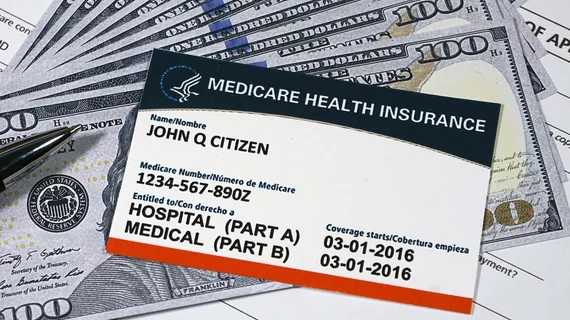Nonphysicians saw a nearly 206% pay bump amid radiologist Medicare reimbursement decline
While radiologists recorded Medicare payment declines from 2005 to 2021, other nonphysician providers saw their own collections leap nearly 206%, according to research published Friday.
Congressional budget requirements mean that any pay bump to one fee-for-service provider type necessitates balancing cuts to others. During a 15-year period, this has resulted in redistribution of Medicare dollars, with overall doc reimbursement falling 2.3% while nurse practitioners, physician assistants and others saw their share swell threefold.
Amid this reality, Neiman Health Policy Institute experts believe Congress must act to protect physician practice viability, according to research published in INQUIRY: The Journal of Health Care Organization [1].
“Policymakers should consider the degree to which cumulative reimbursement declines may impact access to care, particularly for procedural specialties,” Eric W. Christensen, PhD, research director at the Neiman Institute, established by the American College of Radiology in 2012, and co-authors wrote April 26. “Policies that favor one group of clinicians have to come from other clinicians due to budget neutrality’s zero-sum nature, particularly in an environment with statutorily frozen Medicare physician payments or with payment increases below inflation.”
Neiman scholars analyzed 100% of Medicare Part B claims data for the study, calculating per-beneficiary reimbursement by specialty and adjusting for inflation. Changes varied dramatically, with cardiac surgeons recording a nearly 58% payment decline while pain management specialists saw reimbursement swell over 189%. Across all medical providers and suppliers, per-beneficiary payments dropped almost 10% between 2005 to 2021. Limited-license physicians such as podiatrists saw pay increase of roughly 16%. Meanwhile, independent diagnostic testing facilities, ambulatory surgery centers, clinical laboratory and other Medicare suppliers saw gains of more than 44%.
Pay remained relatively stagnant for experts in family medicine (up 0.9%) and radiation oncology (down 0.7%). Sixteen physician specialties recorded reimbursement declines, and 13 of them saw higher patient volumes per beneficiary during that time. This included radiology, anesthesiology, cardiology and others.
For radiologists, the numbers were as follows:
- Change in RVUs: +13.1%.
- Change in nominal reimbursement: +4.2% (not inflation adjusted).
- Change in real reimbursement: -24.9% (inflation adjusted).
Physician specialties would have had to increase volume of services by nearly 51% to maintain the same per-beneficiary reimbursement during the study period, the authors noted. This is forcing radiologists and other docs to work harder to make the same amount of money they did in the past, and it may encourage some to stop accepting new Medicare beneficiaries, researchers contend.
“While reducing physician payments can help to contain Medicare expenditures, it may also lead to unintended consequences for patients,” radiologist Joshua Hirsch, MD, vice chair of procedural services at Boston-based Massachusetts General Hospital, said in an announcement from the Neiman Institute. “Continued decline of Medicare reimbursement relative to reimbursement by private insurance incentivizes providers to favor privately insured patients. Our study pinpoints the extent to which real decreases in reimbursement are occurring despite greater consumption of care. We hope this study will motivate policy makers to find a solution that inures to the benefit of the Medicare insured population who are at risk for diminishing access to care.”
Read much more, including potential study limitations, at the link below.

